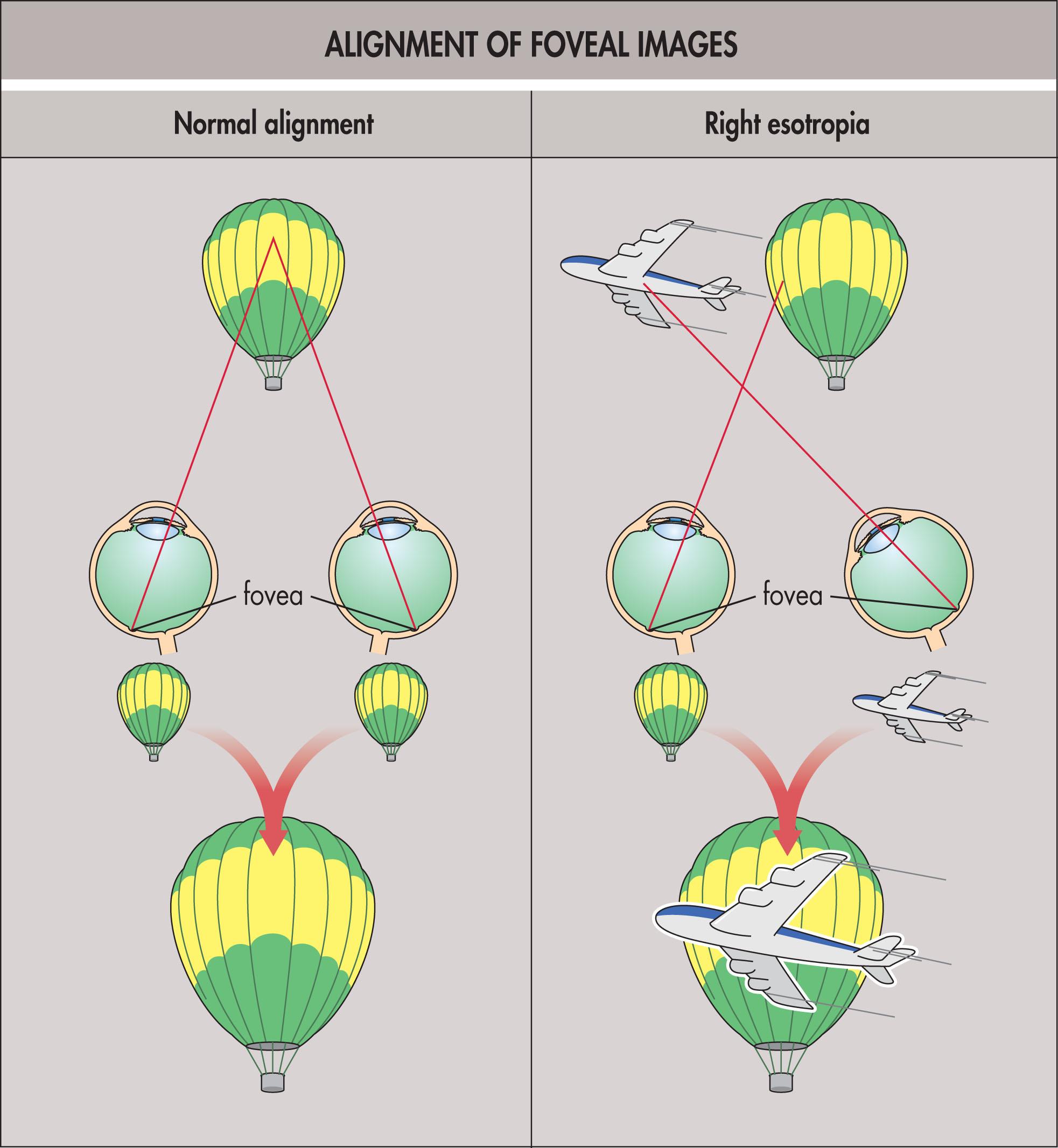Physical Address
304 North Cardinal St.
Dorchester Center, MA 02124
Suppression: Cortical synaptic inhibition preventing conscious appreciation of diplopia and visual confusion in patients with strabismus.
Anomalous correspondence: Cortical adaptation to early-onset, long-standing, stable-angle strabismus that permits crude binocular vision.
Monofixation syndrome: A form of anomalous binocular vision featuring peripheral fusion and reduced stereopsis in patients incapable of bifoveal fusion.
Suppression is regional, determined by the direction and angle of strabismus, and may be superficial or deep-seated, depending on the age of onset and duration of associated strabismus.
Anomalous retinal correspondence results in the formation of an anomalous horopter and Panum’s area and a reassignment of the subjective visual direction of retinal elements in the nonfixating eye under binocular conditions.
Monofixation syndrome is a disorder of binocular vision and can be diagnosed with sensory testing.
The human brain can extract detailed information about a three-dimensional world from a pair of two-dimensional images, thanks to extensively overlapping and corresponding visual fields and elegant cortical processing. This ability is binocular vision, consisting of a range of binocular functions, including sensory fusion, motor fusion, and stereopsis, that rely on the brain’s ability to recognize matching (or corresponding) inputs from the two eyes. (See Chapter 11.4 .) These binocular functions develop gradually from age 2 months through ages 7–9 years, a period of time known as the critical (or sensitive ) period .
The onset of strabismus in a mature patient with normal binocular vision will result in diplopia, visual confusion, and loss of stereopsis. Diplopia occurs when similar images fall on noncorresponding retinal elements. The image will fall onto the nasal retina of an esotropic eye, project a second image in the temporal field, and create uncrossed or homonymous diplopia. An image will fall onto the ipsilateral temporal retina in an exotropic eye, project to the nasal field, and create crossed or heteronymous diplopia. Diplopia may be controlled by fusional vergence or obstructed by the occlusion of one eye. Severely decreased acuity or visual field loss in one eye does not necessarily prevent the appreciation of diplopia.
Visual confusion is less commonly reported by strabismic patients with normal binocular vision. It is the result of irreconcilably dissimilar images projecting onto corresponding points of each eye, such as the foveae, which localize the dissimilar images to the same spatial location ( Fig. 11.5.1 ).

Stereopsis is exquisitely sensitive to eye alignment. The onset of a microtropia in a visually mature patient with normal binocular vision will extinguish stereopsis until alignment is restored. Although diplopia may be the most common symptom, some patients will identify visual confusion or loss of stereopsis as equally or more disruptive.
The ideal outcome for a patient with diplopia, visual confusion, and loss of stereopsis as a result of acquired strabismus is the restoration of binocular single vision in all gaze positions. Nonsurgical interventions, such as fusion exercises, prisms, occlusion, or optical fogging, can be used indefinitely or as a temporizing measure until strabismus surgery is possible and warranted. Botulinum toxin or bupivacaine injections to the extraocular muscles to temporarily correct the strabismic deviation also have been used to eliminate diplopia. (See Chapter 11.2 .)
The onset of strabismus during the critical period tends to have a different sensory outcome because of the immature visual system’s ability to adapt to decorrelated images. This adaptation is best accomplished if the strabismus is constant, relatively comitant (symmetrical), stable, and long-standing.
Suppression is the visual system’s defense against diplopia and visual confusion. The younger the child at the onset of the strabismus, the more rapidly and completely suppression will develop. 2 Synaptic inhibition in the visual cortex prevents the diplopic image from reaching consciousness under binocular conditions. In well-established suppression, the scotoma may be present even when the strabismus is controlled with motor fusion, or corrected optically or surgically, as long as both eyes are open. The persistence of suppression following optical or surgical realignment is one factor that will continue to impede stereopsis after realignment.
In addition to being facultative, suppression is regional. The shape, size, and depth of the suppression scotoma vary with the direction and amplitude of the ocular deviation. In this way, peripheral fusion can sometimes be maintained, despite the presence of suppression. An esotrope will develop suppression of the nasal retina from the deviation point to the fovea. The suppression scotoma in exotropia involves the temporal retina and tends to be much larger ( Fig. 11.5.2 ). Suppression scotomata also vary in responsiveness to stimuli based on age of onset, duration, and direction of misalignment. Rarely is suppression absolute.

Anomalous retinal correspondence (ARC) is the adaptation to misaligned visual axes in which the subjective visual directions of the nonfixating eye are shifted relative to those of the fixating eye under binocular conditions to allow crude binocular vision. A nonfoveal retinal element in the deviating eye acquires an anomalous common visual direction with the fovea of the fixating eye. The fovea of the deviating eye may acquire a new visual direction as well, given enough time and with a stable angle of modest size. Significant neuroplasticity in the developing visual cortex allows for neuronal connections to be made between nonadjacent ocular dominance columns. This results in the formation of a new, anomalous horopter and Panum’s area, which in turn permits a fusion response in the presence of a manifest deviation. ARC develops gradually and often incompletely. The restored fusion is coarse, often limited to peripheral sensory fusion. Small- to moderate-angle strabismus may allow for anomalous motor fusion as well. However, perception of true stereopsis in the presence of a small-angle tropia is very rare.
Become a Clinical Tree membership for Full access and enjoy Unlimited articles
If you are a member. Log in here